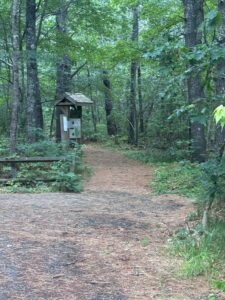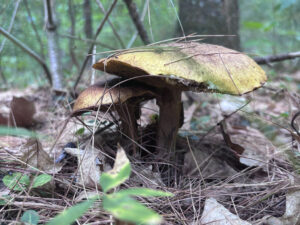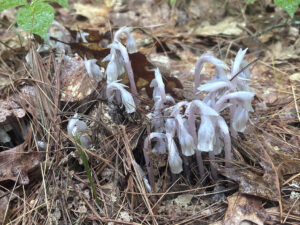 Over the past couple of months, I’ve been taking daily walks through the woods, tuning my city-boy senses to the forest floor and the canopy above – the sounds, the smells, the birds, the dragonflies, and, inevitably, the mosquitoes (I keep forgetting repellent).
Over the past couple of months, I’ve been taking daily walks through the woods, tuning my city-boy senses to the forest floor and the canopy above – the sounds, the smells, the birds, the dragonflies, and, inevitably, the mosquitoes (I keep forgetting repellent).
One morning after an evening’s rainstorm, I came across a patch of yellow mushrooms next to my regular path. The next day, they were gone. Instead there were new blooms, ghostly white emerging from the forest floor, translucent.
Later, with a bit of research, I learned more. (Knowledge for knowledge’s sake, don’t worry, I’m not foraging.) The yellow ones were Slippery Jacks, Suillus americanus. The otherworldly – Indian Pipes, Monotropa uniflora. And to my delight, I found out both are masters of self-organization, finding optimal growth conditions, and symbiosis.
No project manager assigned these partnerships. No org chart mandated them. They found their place along this trail through signals and stayed because of mutual benefit and compatibility.
They’ve been part of an agile system for millions of years – no consultants, no management layers, no forced frameworks. They aren’t victims being fed shit in the dark!
The Slippery Jack Partnership Model
 The Two-Way Value Exchange
The Two-Way Value Exchange
Location. Location. Location. Those Slippery Jacks I noticed weren’t randomly scattered through the forest. They were in the “drip zone” of pine trees – the sweet spot where the branches end, where the finest feeder roots are concentrated, where the rainwater drips off the needles and creates ideal moisture conditions.
Each small cluster was surface evidence of a much larger, invisible collaboration happening in the soil – a win-win story. The fungus’s mycorrhizal network extends the tree’s root system, dramatically increasing its ability to absorb nutrients and fight off diseases. In return, the tree provides a steady supply of sugars and carbohydrates through photosynthesis. The relationship can persist for decades once established. Neither tree nor fungus could achieve its full potential alone.
The Indian Pipes Network Model
 Tapping Into Existing Networks
Tapping Into Existing Networks
The Indian Pipes were more intriguing. These ghostly white, translucent plants have mastered a three-way partnership: technically, they are parasitic on the mycorrhizal fungi and their symbiotic relationship to the pine. The Indian Pipes tap into this exchange without disrupting it by adding their own value – breaking down organic matter and cycling nutrients back into the system, which in turn feeds the whole system.
Lessons For Teams
These examples mirror the best team dynamics I’ve witnessed. Not the working groups that get assembled by spreadsheet, but the ones that naturally form around shared value streams.
Teams where folks choose to collaborate in real-time together because they recognize they can accomplish something greater by swarming than by passing Jira tickets back and forth. People who seek out informal networks to leverage and get things done.
Like the QA engineer who joined forces with the customer support team to create faster feedback loops, tapping into their direct customer insight instead of waiting for formal requirements documents. Or the development team that connected directly with the sales engineers who were fielding technical questions, creating a flow of real-world usage patterns and immediate product improvements.
These teams created their own drip zones – conditions where both individual growth and collective performance naturally thrive.
- A backend developer gets to explore new technologies while solving real user problems.
- A UX designer gets to see their visions come to life with elegant implementation.
- A product owner gets rapid feedback loops and genuine innovation.
Like the forest ecosystem, this doesn’t happen by accident. Teams must actively seek partnerships based on mutual benefit – not just wait for assignments. It means recognizing the signals of compatibility – shared values, complementary skills, aligned motivations – rather than just checking boxes on a resource allocation matrix.
Finding Your Drip Zone
To get started, map your team’s current partnerships and interconnections. Draw yourselves in the center, then identify all the other teams, individuals, or systems you interact with regularly.
Who do you depend on for information, feedback, or resources? Who depends on you? Where do you see potential for more direct collaboration that bypasses traditional handoffs? Where might there be energy drains?
Which relationships feel like there’s mutual benefit (like the Slippery Jacks and pine trees) versus purely transactional exchanges?
Look for your “Indian Pipes opportunities” – where could you tap into existing knowledge networks more directly? Maybe the customer support team has insights that could shortcut your user research. Maybe the infrastructure team has automation tools that could solve problems you’ve been building workarounds for.
The goal isn’t to eliminate all formal structure, but to find which arise naturally from the work versus which ones exist because “that’s how we’ve always done it.” These emergent networks make local decisions quickly. They self-correct when something isn’t working as well as it could be.
The role of leadership shifts from directing/controlling to creating better environmental conditions for collective wisdom to thrive. (And in the process, not to fret! As Sandy Mamoli puts it perfectly in her work on self-selecting teams: “Everything people ever worry about doesn’t happen. It’s totally different things that happen. So you might as well do it and deal with the actual problems that happen, rather than the worries that never eventuate.”)
For Teams with Autonomy: Y’all Can Just Do It
Pick one partnership that could work more like a natural forest collaboration. Launch a timeboxed experiment. Instead of formal processes and scheduled meetings, experiment with more direct collaboration. Set up shared channels, rotate people between teams for short periods, or create small cross-functional groups focused on specific outcomes. Let people self-select into the roles needed to deliver end-to-end value. See what naturally emerges when you optimize for customer success rather than departmental efficiency.
For Teams in Rigid Hierarchies: Finding Some Canopy Cover
Identify one opportunity for improvement and pitch it to “the powers that be” using David Marquet’s intent-based leadership language: “We intend to try X partnership for Y timeframe to accomplish Z outcome. What might we be missing?” Acknowledge authority while demonstrating thoughtful intent.
Hopefully, you’ll be able to avoid a pattern I’ve seen repeated: organizational immune systems that can’t distinguish between dysfunction and natural, healthy self-organization. They see something differently and assume it needs to be “fixed” rather than protected and nurtured. That triggers standardization, reporting, and/or scaling efforts. All will kill the very thing that is emerging.
AI Agents Entering Our Forests
New Species, Same Principles
After drafting the above and once again walking those woods, I started thinking about how AI agents might fit into healthy team ecosystems. Not as replacements thrust upon teams from above, but as partners that teams choose when they add genuine value.
Healthy ecosystems have always incorporated new participants when they fill genuine gaps or create new possibilities. The forest doesn’t reject newcomers – it integrates them when they contribute to the overall system’s health. The most effective AI approaches follow this pattern.
Partnership, Not Replacement
Try piloting an AI agent on a low-risk process and observe how it meshes with your team’s workflow.
Some teams are implementing agents to handle routine tasks, like the mycorrhizal networks that automatically route resources where they’re needed. This frees up the humans to focus on strategic thinking, architecture and creative problem-solving.
Others are finding AI partners for work that humans don’t want to do, similar to how decomposer organisms handle the crucial but unglamorous work of breaking down waste. A customer success team might use an AI agent to surface patterns from support tickets, while the sapiens handle the relationship building and complex issue resolution that requires human judgment.
Just like the Slippery Jacks and pine trees, these work because both parties bring something essential to the partnership.
The key difference from “Install AI” is that teams are self-selecting these partnerships based on actual needs they’ve identified, rather than having AI solutions inflicted because someone somewhere decided the teams should be “more efficient,” “do more with less,” “follow the herd,” blah blah blah.
Your Forest Awaits
Forests have self-organized for hundreds of millions of years. No consultants arrived to design the cooperative between slippery jacks and pine trees. No management layer mandated that Indian pipes tap into mycorrhizal networks. No standardization committee decided how species should collaborate.
Yet these systems exhibit coordination, resilience, and efficiency that puts most of our organizational charts to shame.
Your team already has the right instincts. You’ve probably experienced glimpses of it – those moments when everything clicked, when barriers dissolved, when work was effortless because they were operating in the collective drip zone.
The question isn’t whether self-organizing teams can work. The question is whether we’re brave enough to trust what we already know: that people naturally want to contribute, that partnerships form when there’s mutual benefit, and that the best structures emerge from the work itself rather than being imposed.
Take a walk through your organization’s forest. Where are your drip zones? What natural co-ops are waiting to emerge?
Start where you are. Use what you have. Do what you can. Find your Slippery Jack partnerships. Identify your Indian Pipe opportunities. Experiment with AI agents as ecosystem partners, not replacements. Protect the natural patterns that emerge from organizational immune responses that want to “improve” them.
Your forest awaits. And unlike the tired old mushroom metaphor, you won’t be kept in the dark.
Read More
- Dynamic Reteaming: The Art and Wisdom of Changing Teams
- Self-Selection: Start Small, Think Big
- Six Steps Towards Self Learning Teams and Organizations
- There is No CEO Tree in the Forest: How Ecosystems Distribute Leadership
- Intent Based Leadership with David Marquet
- Thieves of Time Retrospective
